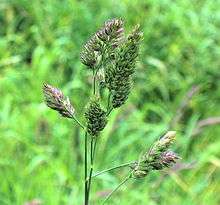Dactylis
Dactylis is a genus of Eurasian and North African plants in the bluegrass subfamily within the grass family.[3][4] They are known in English as cock's-foot or cocksfoot grasses, also sometimes as orchard grasses.
| orchard grasses cock's-foot | |
|---|---|
 | |
| Dactylis glomerata in Dornoch, Scotland | |
| Scientific classification | |
| Kingdom: | Plantae |
| Clade: | Tracheophytes |
| Clade: | Angiosperms |
| Clade: | Monocots |
| Clade: | Commelinids |
| Order: | Poales |
| Family: | Poaceae |
| Subfamily: | Pooideae |
| Supertribe: | Poodae |
| Tribe: | Poeae |
| Subtribe: | Dactylidinae |
| Genus: | Dactylis L. |
| Species and subspecies[1] | |
| |
| Synonyms[2] | |
| |
Taxonomy
The genus has been treated as containing only a single species Dactylis glomerata by many authors, treating variation in the genus at only subspecific rank within D. glomerata,[5][6][7] but more recently, there has been a trend to accept two species,[8] while some authors accept even more species in the genus, particularly island endemic species in Macaronesia.[9][10][11][12]
Description
Dactylis species are perennial grasses, forming dense tussocks growing to 15–140 centimetres tall, with leaves 20–50 cm long and up to 1.5 cm broad, and distinctive tufted triangular flowerheads comprising a panicle 10–15 cm long, turning pale grey-brown at seed maturity. The spikelets are 5–9 mm long, typically containing two to five flowers. The stems have a flattened base, which distinguishes them from many other grasses.[6][13][14][15]
- Accepted species[2]
- Dactylis glomerata L. - Eurasia and North Africa; naturalized in southern Africa, Australia, the Americas, and various oceanic islands
- Dactylis smithii Link - Canary Islands, Cape Verde, Madeira
- formerly included[2]
Many species now considered better suited to other genera: Aeluropus Ammochloa Cutandia Desmostachya Dinebra Elytrophorus Eragrostis Festuca Koeleria Odyssea Poa Rostraria Schismus Spartina Tribolium Trisetaria Wangenheimia
Cytology
The taxa show several different levels of polyploidy. Dactylis glomerata subsp. glomerata and D. glomerata subsp. hispanica are tetraploid forms with 28 chromosomes. Several of the other taxa, including D. glomerata. subsp. himalayensis (syn. D. himalayensis), D. glomerata subsp. lobata (syn. D. polygama), D. metlesicsii, and some forms of D. smithii, are diploid with 2n = 14; hexaploids with 42 chromosomes also occur rarely.[6][10][16]
References
- "Dactylis" (HTML). NCBI taxonomy. Bethesda, MD: National Center for Biotechnology Information. Retrieved 14 January 2019.
- Kew World Checklist of Selected Plant Families
- Linnaeus, Carl von. 1753. Species Plantarum 1: 71. in Latin
- Tropicos, Dactylis L.
- Flora Europaea: Dactylis glomerata Archived 2011-07-24 at the Wayback Machine
- Flora of China Town: Dactylis
- Wetschnig, W. (1991). Karyotype morphology of some diploid subspecies of Dactylis glomerata L. (Poaceae). Phyton (Horn, Austria) 31 (1): 35-55 fulltext
- Germplasm Resources Information Network: Species Records of Dactylis, Dactylis glomerata.
- Parker, P. F. (1972). Studies in Dactylis II. Natural variation, distribution and systematics of the Dactylis smithii Link. complex in Madeira and other Atlantic islands. New Phytologist fulltext
- Schönfelder, P., & Ludwig, D. (1996). Dactylis metlesicsii (Poaceae), eine neue Art der Gebirgsvegetation von Tenerife, Kanarische Inseln. Willdenowia 26 (1–2): 217–223. Full text Archived 2011-06-15 at the Wayback Machine
- Banco de Datos de Biodiversidad de Canarios Lista de especies silvestres de Canarias: hongos, plantas y animales terrestres Archived 2011-04-10 at the Wayback Machine
- Flora of Pakistan: Dactylis
- Kew GrassBase: Dactylis
- Interactive Flora of NW Europe Dactylis glomerata (Cock's-foot)
- FAO factsheet: Dactylis glomerata
- Míka, V., Kohoutek, A., & Odstrèilová, V. (2002). Characteristics of important diploid and tetraploid subspecies of Dactylis from point of view of the forage crop production. Rostlinná Výroba 48 (6): 243–248. Full text Archived 2011-07-18 at the Wayback Machine